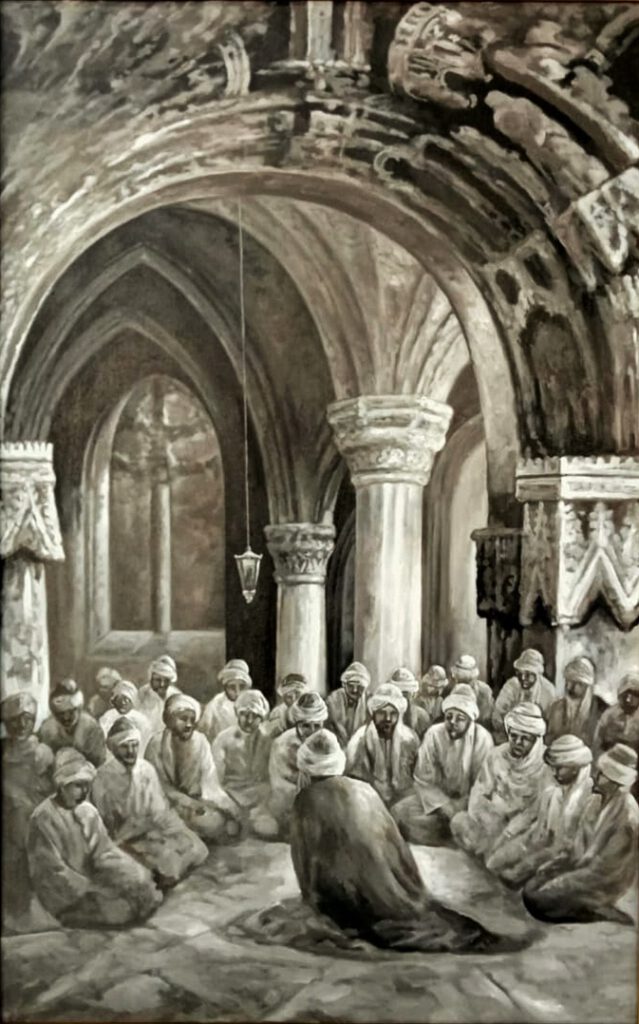
A murshid is a spiritual teacher whose words are listened to, whose words are obeyed, and whose actions are imitated by their disciples. A Murshid can see the diseases in the human soul, and especially those of his disciples. Imam Al-Ghazali explained that there are two kinds of science, which are very important to human life. First, the medical science that treats a person’s physical body. Second, the science of the human soul, which treats the diseases of the human soul. The human body and soul form the human unit, and both must therefore be treated, if one or both are sick. It is not the murshid‘s duty to treat physical ailments, but the human mind or spirit.
In Sufism literature, a murshid is referred to as a spiritual guide for those people who take a special path to get closer to God. In doing so, it is important to purify the soul of characteristics that stand in the way when a person tries to approach the Most Holy Essence. This only works if the person gets rid of the idea of being sacred oneself. A person must purify the spiritual heart because God is the Holiest and one can only approach Him with a cleared, purified soul. Thus, the murshid guides the disciple to become a salik (seeker of God) and to walk the path of getting as close as possible to God and thereby purifying and enriching one’s character.
It is a murshid’s duty to teach the salik, who is serious about getting to know God, to understand the spiritual paths to God, to guide him/her, to educate and to mold his/her soul. The murshid leads the salik with determination and discipline. This path begins with the process of purification/ catharsis of the soul (tazkiyah al-nafs) until the salik comes to a deep understanding (ma’rifat) of Al-Haqq (one of God’s names). The murshid’s duties and roles towards the salik are similar to those of God’s Messenger, the Prophet Muhammad, towards his companions. The companions were disciplined and full of humility in front of the Prophet and the same applies for the salik towards the murshid. This spiritual relationship between a teacher and his disciple is illustrated in my painting. The murshid is portrayed in his role as a spiritual leader who fulfils his duties towards his disciples, to educate them and to mould their souls.
The role of a murshid is a gift and an entrusted good from God to people of noble descendance. A drop of blood running through his body is a destiny of God. A person cannot call oneself a murshid, and noble descendance is no guarantee of receiving the entrusted good and becoming a murshid. Like gold that is trapped in a rock and needs to be extracted from the stone, worked, forged, and polished, it is impossible for someone with a noble destiny to be commissioned to become a murshid without going through the school of purification/ catharsis of the soul. ‘Gold’ that is still in the bowels of the earth can only be extracted and worked by experts in spiritual ‘mining’. Without this process, it does not matter how good the ‘gold’ is, it is of no worth when trapped in a rock. By using spiritual tools, a murshid has the potential to give birth to a thousand more murshids. This can happen through face-to-face encounters or through a strong and continuous spiritual contact of the Murshid with the soul of the disciples.
Note on translation
- Salik does not only refer to male seekers of God, but also includes women who are on their way to purify their souls and get closer to God. The same applies to the murshid. Women can also be spiritual guides on the path to come closer to God.
- Imam Al-Ghazali (1058-1111) is one of the most important Islamic theologians, philosophers, and mystics. One of his most famous works is the revival of the religious sciences, which consists of 40 books.
- The purification/ catharsis of the soul (tazkiyahal-nafs) is an essential part of the Islamic religion and not just part of Islamic mysticism, as it is often wrongly interpreted. The Islamic religion consists of three large, fundamental parts: Islam, Iman and Ihsan.
- Islam refers to the external aspects to be considered a Muslim and includes pronouncing the confession of faith, conducting the five daily ritual prayers, paying the wealth tax (zakat), fasting in Ramadan, and making the pilgrimage (hajj) to Mecca for those who are financially and physically able to do so.
- Iman refers to the internal aspects of the religion, the Islamic beliefs. A Muslim believes in the One God, in the angels, the revealed books, in God’s prophets and messengers, in the Last Day and in fate and predestination.
- Ihsan refers to the awareness that God is always seeing you and is aware of a person’s actions. This should lead to an awareness that leads to beautiful behaviour/ demeanour towards God, his prophets and books, as well as towards other people and towards creation in general, as well as towards oneself. The purification/ catharsis of the soul and what the artist Muhammad Andik described in his concept are located within Ihsan.
- The masculine pronoun for God does not imply that God is male. God is above any attribution of properties that exist in creation, including the attribution of gender. The use of the masculine pronoun for God refers purely to the grammatical gender in the English language.
- Al-Haqq, the Absolute Truth, is one of the 99 most beautiful names of God that have a special and significant role in Islam.
- When Muslims mention the Prophet Muhammad, they also send blessings on him, e.g.: May God bless him and give him peace.
